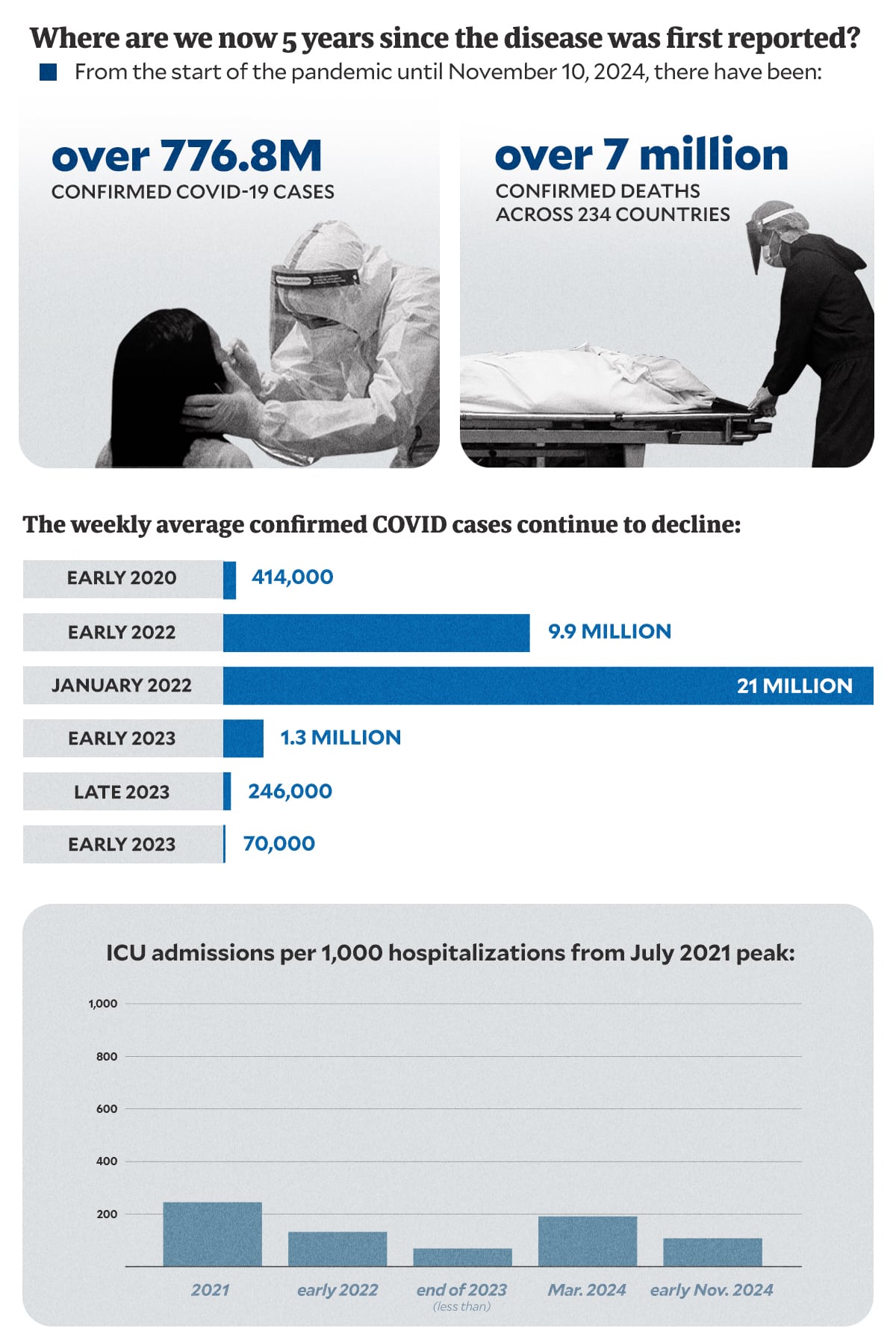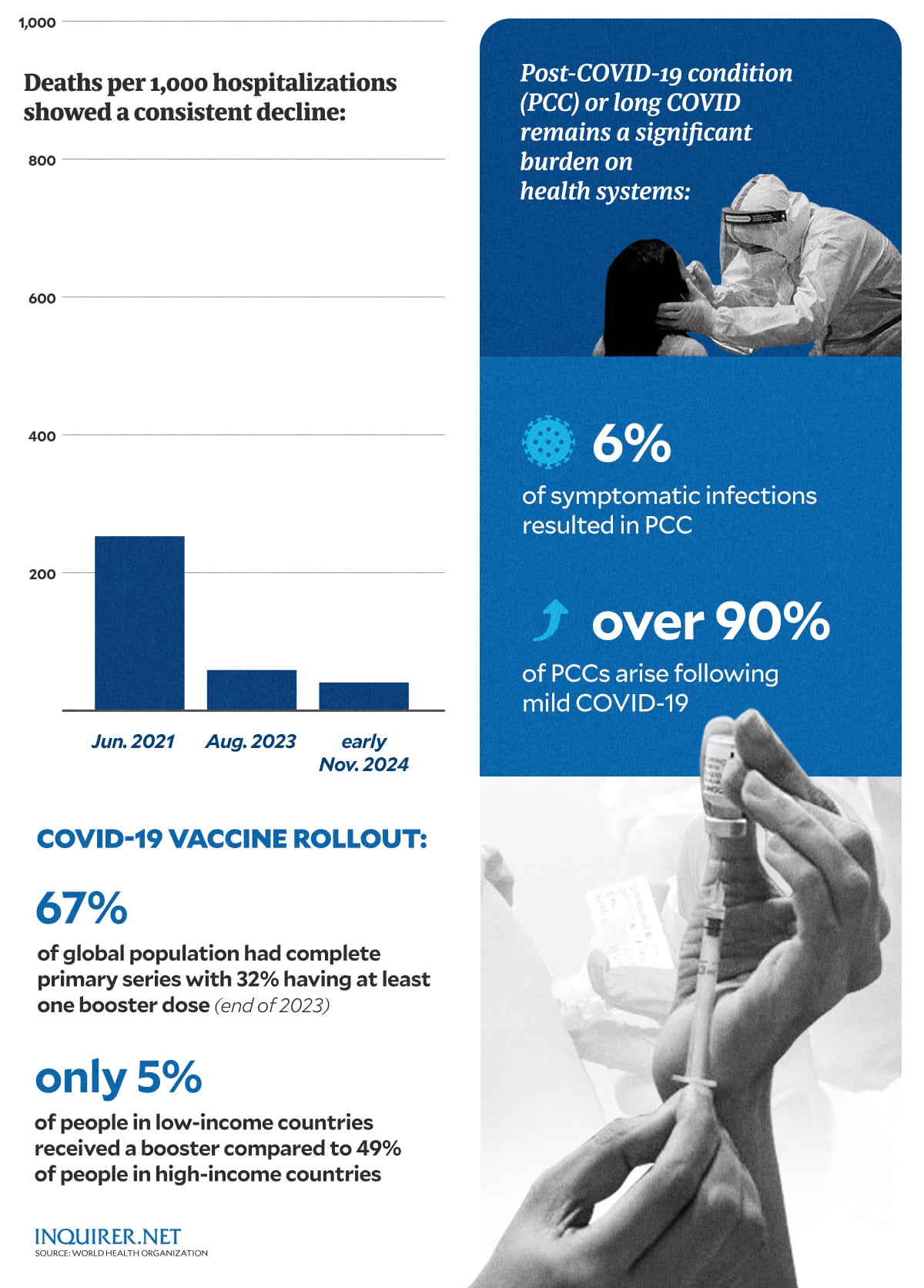COVID-19 global overview: Where are we now 5 years after?
MANILA, Philippines—Nearly five years after COVID-19 was first reported, the World Health Organization (WHO) warned that the disease continues to spread unpredictably and causes severe illness worldwide.
According to WHO, reduced surveillance and inconsistent prevention efforts are making it tougher to track and manage the virus effectively.
A now archived timeline by the WHO detailed that on December 31, 2019, the Wuhan Municipal Health Commission in China reported a cluster of cases of pneumonia in Wuhan, Hubei Province. Following this, a novel coronavirus was eventually identified.
Nearly five years after this incident, WHO noted that while there are periodic waves of the disease in some countries, the SARS-CoV-2 virus, which causes COVID-19, “largely circulates without clear seasonality” and continues to infect individuals, causing severe acute disease and post-COVID-19 condition (PCC).
By the numbers
In a special edition of its epidemiological update on COVID-19, WHO reported that, from the start of the pandemic until November 10, 2024, there were over 776.8 million confirmed cases of COVID-19 and more than 7 million confirmed deaths. These figures were reported across 234 countries, areas, and territories.
Article continues after this advertisementBetween early 2020 and early 2022, COVID-19 cases skyrocketed from 414,000 to nearly 10 million per week, peaking at 21 million in January 2022.
Article continues after this advertisementBy mid-2022, cases began to drop, partly due to less testing and fewer countries reporting cases. Weekly cases continued to decline, falling from 1.3 million in early 2023 to just 70,000 by early 2024.
WHO explained that 95 percent of the total COVID-19-related deaths were reported in 2020, 2021, and 2022.
“Increased immunity from infection and/or vaccination resulted in a significant decrease in deaths from the second half of 2022,” WHO said.
Weekly reported COVID-19 deaths rose sharply from 21,000 in early 2020 to a peak of 99,000 in January 2021. By the end of 2021, official reports counted 5.49 million deaths, but WHO estimates suggest the true toll for 2020-2021 was much higher at 14.91 million.
Deaths steadily declined afterward, dropping to 33,000 in early 2022, 13,000 by late 2022, 8,000 in early 2023, 2,400 by late 2023, and 1,400 in early 2024. WHO clarified they are still calculating the global excess mortality for 2022 to 2024.
Older adults aged 65 and above remain the most vulnerable to severe COVID-19 and death. In contrast, children under 15 account for just 0.2 percent of global reported COVID-19 deaths, with 60 percent of those occurring in children under five.
However, WHO noted that while the overall deaths among children under 15 have decreased since 2020, the share of deaths among children under five has grown, rising to 68 percent in 2023 and 75 percent in 2024 of all reported deaths in this age group.
“Although the global WHO COVID-19 database does not have the further age breakdown, the WHO clinical platform report, which analyzed the data from 50,351 children and adolescents, found that infants have the highest mortality risk, comparable to that of adults aged 20-45 years,” the UN agency added.
Less hospitalization, long COVID persists
Between January 2020 and November 2024, over 28 million COVID-19 hospitalizations were reported globally, making up about 5 percent of confirmed cases. Hospitalizations peaked at 526,000 weekly in early 2021 but dropped to 13,000 by 2024 as vaccinations and immunity increased.
ICU admissions and deaths per 1,000 hospitalizations also declined significantly, though changes in reporting make recent trends harder to analyze.
WHO also reported that post-COVID-19 condition (PCC), also known as “long COVID,” remains a significant burden on health systems.
READ: Understanding ‘long COVID’ and how to prevent it
READ: New studies shine light on need for long COVID research in PH
“At the present time, with differences in case definitions used by Member States, limited studies and resources for PCC, it is challenging to estimate the incidence of PCC with high precision, but available data from multiple countries suggests that approximately 6 percent of symptomatic SARS-CoV-2 infections resulted in PCC,” said WHO.
The UN agency discovered that the majority of long COVID cases originate from mild infections rather than severe ones. This is largely due to the high number of people infected over the past five years. Additionally, vaccination has been shown to reduce the risk of developing long COVID.
Global vaccine rollout
When the COVID-19 vaccine rollout started in 2021, higher-income countries initially had higher vaccination rates. By the end of 2023, about 2 in 3 people worldwide had completed their primary COVID-19 vaccine series, and 1 in 3 had received at least one booster.
However, there were big gaps in coverage: only 1 in 20 people in low-income countries got a booster, compared to nearly 1 in 2 in high-income countries.
Among older adults, 83 percent had a complete primary series and 61 percent had a booster, and among health workers, 89 percent had a complete primary series and 31 percent had a booster.
Challenges amid virus evolution
Since its emergence, SARS-CoV-2 has evolved, with key variants like Alpha, Beta, Gamma, Delta, and Omicron, each bringing new traits that affect how easily it spreads, how severe it is, and how effective vaccines are.
READ: Omicron: What science knows so far about latest Greek-lettered COVID variant
Omicron itself has produced subvariants like BA.1, BA.2, and BA.5, leading to multiple waves of infections. By 2023, new recombinant subvariants like XBB and XBB.1.5 appeared, with BA.2.86 becoming prominent by late 2023.
As of December 2024, KP.3.1.1 and XEC are the most common descendants, with XEC increasing in prevalence.
READ: Unending mutation of the COVID virus brings a new creature: BA.2.75
READ: EXPLAINER: What’s COVID FLiRT and variants now in PH?
As the virus evolves and new variants emerge, health systems — including WHO’s ability to track its spread, severity, and impact of mutations — face growing challenges.
“The impact of COVID-19 has varied by country depending on the circulating variants, national policies, capacities to respond, and access to countermeasures,” said WHO.
Reduced surveillance, testing, and sequencing, along with limited integration into long-term infectious disease prevention programs, have made monitoring more difficult as countries shift from crisis management to long-term COVID-19 control.
“Changes to COVID-19 surveillance over the past five years have been consistent and expected, adapting to the changing landscape of the pandemic. Many Member States are transitioning from comprehensive case reporting to integrating SARS-CoV-2 monitoring into existing respiratory disease and infectious diseases surveillance systems,” WHO explained.
“This is an important step towards sustainable infectious disease surveillance, monitoring and risk assessment,” it added.
For more news about the novel coronavirus click here.
What you need to know about Coronavirus.
For more information on COVID-19, call the DOH Hotline: (02) 86517800 local 1149/1150.
The Inquirer Foundation supports our healthcare frontliners and is still accepting cash donations to be deposited at Banco de Oro (BDO) current account #007960018860 or donate through PayMaya using this link.


